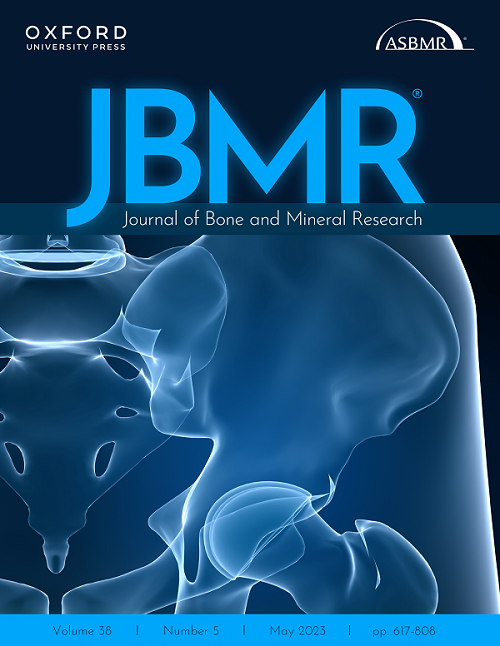求助PDF
{"title":"斑马鱼中骨化性纤维发育不良进展型I型BMP受体ACVR1的GS结构域丝氨酸/苏氨酸需求减少","authors":"Robyn S. Allen, William D. Jones, Maya Hale, Bailey N. Warder, Eileen M. Shore, Mary C. Mullins","doi":"10.1002/jbmr.4869","DOIUrl":null,"url":null,"abstract":"<div>\n \n <p>Fibrodysplasia ossificans progressiva (FOP) is a rare human genetic condition characterized by altered skeletal development and extraskeletal bone formation. All cases of FOP are caused by mutations in the type I bone morphogenetic protein (BMP) receptor gene <i>ACVR1</i> that result in overactivation of the BMP signaling pathway. Activation of the wild-type ACVR1 kinase requires assembly of a tetrameric type I and II BMP receptor complex followed by phosphorylation of the ACVR1 GS domain by type II BMP receptors. Previous studies showed that the FOP-mutant ACVR1-R206H required type II BMP receptors and presumptive glycine/serine-rich (GS) domain phosphorylation for overactive signaling. Structural modeling of the ACVR1-R206H mutant kinase domain supports the idea that FOP mutations alter the conformation of the GS domain, but it is unclear how this leads to overactive signaling. Here we show, using a developing zebrafish embryo BMP signaling assay, that the FOP-mutant receptors ACVR1-R206H and -G328R have reduced requirements for GS domain phosphorylatable sites to signal compared to wild-type ACVR1. Further, ligand-independent and ligand-dependent signaling through the FOP-mutant ACVR1 receptors have distinct GS domain phosphorylatable site requirements. ACVR1-G328R showed increased GS domain serine/threonine requirements for ligand-independent signaling compared to ACVR1-R206H, whereas it exhibited reduced serine/threonine requirements for ligand-dependent signaling. Remarkably, while ACVR1-R206H does not require the type I BMP receptor partner, Bmpr1, to signal, a ligand-dependent GS domain mutant of ACVR1-R206H could signal independently of Bmpr1 only when Bmp7 ligand was overexpressed. Of note, unlike human ACVR1-R206H, the zebrafish paralog Acvr1l-R203H does not show increased signaling activity. However, in domain-swapping studies, the human kinase domain, but not the human GS domain, was sufficient to confer overactive signaling to the Acvr1l-R203H receptor. Together these results reflect the importance of GS domain activation and kinase domain functions in regulating ACVR1 signaling and identify mechanisms of reduced regulatory constraints conferred by FOP mutations. © 2023 American Society for Bone and Mineral Research (ASBMR).</p>\n </div>","PeriodicalId":185,"journal":{"name":"Journal of Bone and Mineral Research","volume":"38 9","pages":"1364-1385"},"PeriodicalIF":5.1000,"publicationDate":"2023-06-17","publicationTypes":"Journal Article","fieldsOfStudy":null,"isOpenAccess":false,"openAccessPdf":"","citationCount":"0","resultStr":"{\"title\":\"Reduced GS Domain Serine/Threonine Requirements of Fibrodysplasia Ossificans Progressiva Mutant Type I BMP Receptor ACVR1 in the Zebrafish\",\"authors\":\"Robyn S. Allen, William D. Jones, Maya Hale, Bailey N. Warder, Eileen M. Shore, Mary C. Mullins\",\"doi\":\"10.1002/jbmr.4869\",\"DOIUrl\":null,\"url\":null,\"abstract\":\"<div>\\n \\n <p>Fibrodysplasia ossificans progressiva (FOP) is a rare human genetic condition characterized by altered skeletal development and extraskeletal bone formation. All cases of FOP are caused by mutations in the type I bone morphogenetic protein (BMP) receptor gene <i>ACVR1</i> that result in overactivation of the BMP signaling pathway. Activation of the wild-type ACVR1 kinase requires assembly of a tetrameric type I and II BMP receptor complex followed by phosphorylation of the ACVR1 GS domain by type II BMP receptors. Previous studies showed that the FOP-mutant ACVR1-R206H required type II BMP receptors and presumptive glycine/serine-rich (GS) domain phosphorylation for overactive signaling. Structural modeling of the ACVR1-R206H mutant kinase domain supports the idea that FOP mutations alter the conformation of the GS domain, but it is unclear how this leads to overactive signaling. Here we show, using a developing zebrafish embryo BMP signaling assay, that the FOP-mutant receptors ACVR1-R206H and -G328R have reduced requirements for GS domain phosphorylatable sites to signal compared to wild-type ACVR1. Further, ligand-independent and ligand-dependent signaling through the FOP-mutant ACVR1 receptors have distinct GS domain phosphorylatable site requirements. ACVR1-G328R showed increased GS domain serine/threonine requirements for ligand-independent signaling compared to ACVR1-R206H, whereas it exhibited reduced serine/threonine requirements for ligand-dependent signaling. Remarkably, while ACVR1-R206H does not require the type I BMP receptor partner, Bmpr1, to signal, a ligand-dependent GS domain mutant of ACVR1-R206H could signal independently of Bmpr1 only when Bmp7 ligand was overexpressed. Of note, unlike human ACVR1-R206H, the zebrafish paralog Acvr1l-R203H does not show increased signaling activity. However, in domain-swapping studies, the human kinase domain, but not the human GS domain, was sufficient to confer overactive signaling to the Acvr1l-R203H receptor. Together these results reflect the importance of GS domain activation and kinase domain functions in regulating ACVR1 signaling and identify mechanisms of reduced regulatory constraints conferred by FOP mutations. © 2023 American Society for Bone and Mineral Research (ASBMR).</p>\\n </div>\",\"PeriodicalId\":185,\"journal\":{\"name\":\"Journal of Bone and Mineral Research\",\"volume\":\"38 9\",\"pages\":\"1364-1385\"},\"PeriodicalIF\":5.1000,\"publicationDate\":\"2023-06-17\",\"publicationTypes\":\"Journal Article\",\"fieldsOfStudy\":null,\"isOpenAccess\":false,\"openAccessPdf\":\"\",\"citationCount\":\"0\",\"resultStr\":null,\"platform\":\"Semanticscholar\",\"paperid\":null,\"PeriodicalName\":\"Journal of Bone and Mineral Research\",\"FirstCategoryId\":\"3\",\"ListUrlMain\":\"https://onlinelibrary.wiley.com/doi/10.1002/jbmr.4869\",\"RegionNum\":1,\"RegionCategory\":\"医学\",\"ArticlePicture\":[],\"TitleCN\":null,\"AbstractTextCN\":null,\"PMCID\":null,\"EPubDate\":\"\",\"PubModel\":\"\",\"JCR\":\"Q1\",\"JCRName\":\"ENDOCRINOLOGY & METABOLISM\",\"Score\":null,\"Total\":0}","platform":"Semanticscholar","paperid":null,"PeriodicalName":"Journal of Bone and Mineral Research","FirstCategoryId":"3","ListUrlMain":"https://onlinelibrary.wiley.com/doi/10.1002/jbmr.4869","RegionNum":1,"RegionCategory":"医学","ArticlePicture":[],"TitleCN":null,"AbstractTextCN":null,"PMCID":null,"EPubDate":"","PubModel":"","JCR":"Q1","JCRName":"ENDOCRINOLOGY & METABOLISM","Score":null,"Total":0}
引用次数: 0
引用
批量引用


